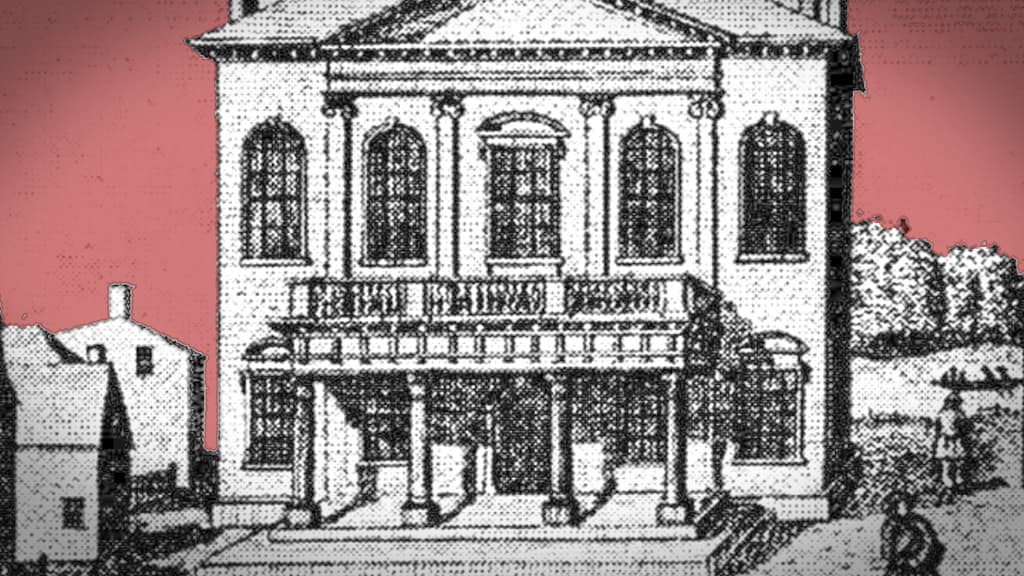1692 Salem Courthouse
Table of Contents
Everything you need to know about the Salem Courthouse of 1692 in a minute-long video! Keep scrolling past the video for a full transcript and much more information.

Welcome to the Salem Spotlight, a series in which I tell you everything you need to know about attractions, restaurants, hotels, witch shops, tours, and a bunch of other locations in Salem, Massachusetts. Today we’re having a look at the Salem Courthouse from 1692.
History of the Salem Witch Trials Courthouse
The Salem Courthouse that would go on to gain so much infamy came into being in 1677. It stood in the middle of Washington Street for forty years.
Of course, 1692 brought what was likely the building’s darkest days: the Salem Witch Trials. During that time, the courthouse was located on the second floor of the Town House.
In May of 1692, Governor William Phips created The Court of Oyer and Terminer. Phips would go on to be largely uninvolved with the Trials until they neared their end. But by the time the court was established, the hysteria was already well underway.
The court initially consisted of Chief Justice William Stoughton and other eight prominent citizens. Among the most noted were Jonathan Corwin (owner of The Witch House), Bartholomew Gedney, and John Hathorne.
The original Salem Witch Trials Courthouse building unfortunately no longer exists. However, at its location, you will find a plaque that memorializes where the old courthouse once stood.
Connection to the Witch Trials
This was the place were those accused of witchcraft were tried and condemned to death. There’s way more information on the Salem Witch Trials on the site page if you’re interested in the full story.
To sum up, a sudden outbreak of witchcraft accusations sprang forth in Salem Village, an adjacent agrarian community that had been taking steps prior to the trials to gain more independence from the urban Salem Town (where modern-day Salem is located).
This was only the second such outbreak (that we know of) in American history up to that point. A smaller, but no less violent surge of witchcraft hangings occurred in Connecticut a few decades prior.
In Salem, nineteen people were sentenced to death by hanging by the Court of Oyer and Terminer. Many enigmatic Salemites lost their lives during the trials or in the wake of its carnage. A few of the more memorable are:
- Rebecca Nurse, who had been among the church’s most loyal servants and was condemned to death largely because old age prevented her from being able to hear the questions thrust upon her during her hearing.
- Sarah Goode, whose daughter was only four years old when she was sent to prison alongside her mother. While the daughter survived, she was badly mentally deranged by the affair and spent the rest of her life in torment.
- Giles Corey, who refused to enter a guilty or innocent plea and was crushed to death for it. Listen to our fictionalized audio drama centering around Giles, his death, and the resulting haunting of Salem below.

The End of the Salem Witch Trials
The executions ended in September of 1692. Shortly after, Governor Phips dissolved the Court of Oyer and Terminer. However, as more than 50 of the accused were still in jail, additional trials were held during 1693. Three of the convicted were actually still found guilty but all of them were reprieved by Phips.
The early hearings were actually held in a number of locations in and around present-day Salem. Such shifts were primarily due to a few key factors. The first is that the Salem Witch Trials largely broke out in an area outside of modern-day downtown Salem.
The earliest accusations and hearings were held much closer to the homes of the infamous teenage girls who set off what would become the trials because it was far easier than traveling into town.
The second reason there were multiple locales is that a courthouse wasn’t really viewed as necessary for the early hearings. Many times the accused were questioned in taverns, meeting houses, etc. It wasn’t until things got formal that the courthouse was established as the primary location for the Salem Witch Trials.
Salem Courthouse Location
The site of the Salem Courthouse: 70 Washington St, Salem, MA 01970. This is right in the middle of present-day downtown Salem.
Unfortunately, there is little resemblance between what an accused with would have seen on this spot in 1692 and what a tourist sees today.
One does get a sense of the past, however, by turning around to face the other side of Washington Street. There, the seat of Salem’s government rests in resplendent, albeit non-spooky, glory.
This location would have been prime during the Salem Witch Trials as well. Not terribly far from this spot, you can still walk to Derby Wharf which would have been teeming with seafarers and tradespeople in the lead-up to and for sometime after the Trials.
The courthouse was a stone’s throw from the prison. And both are about a twenty-five minute walk from the spot were the condemned were hanged.
One easily imagines the final days of the accused’s lives. They must have been spent in a state of abject suffering. The nights chilly and breathless, the mornings stale and unnerving. Until one day a rickety cart came and hauled away the woman across the jail from you.
Or perhaps her husband. Or perhaps on this day it came for you.
From the prison, the accused were carted to Gallow’s Hill (present-day Proctor’s Ledge). There they were hanged, most likely from a tree branch, until dead. The ropes likely were not long enough to break their necks. So it’s highly likely that most of them strangled to death.


Are there witch trials acted out during day?
Not at the courthouse, but nearby! There’s a performance group that does a show called, “Cry Innocent” downtown in Salem. Check them out here: https://cryinnocentsalem.com/